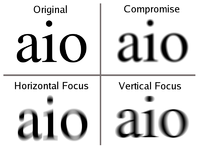
Photo from wikipedia
Inadequate supplies of donor corneas have evoked an escalating interest in corneal xenotransplantation. However, innate immune responses contribute significantly to the mechanism of xenograft rejection. We hypothesized that complement component… Click to show full abstract
Inadequate supplies of donor corneas have evoked an escalating interest in corneal xenotransplantation. However, innate immune responses contribute significantly to the mechanism of xenograft rejection. We hypothesized that complement component C5 and TLR co-receptor CD14 inhibition would inhibit porcine cornea induced innate immune responses. Therefore, we measured cytokine release in human blood, induced by three forms of corneal xenografts with or without inhibitors. Native porcine cornea (NPC) induced interleukins (IL-1β, IL-2, IL-6, IL-8, IL-1ra), chemokines (MCP-1, MIP-1α, MIP-1β) and other cytokines (TNF, G-CSF, INF-γ, FGF-basic). Decellularized (DPC) and gamma-irradiated cornea (g-DPC) elevated the release of those cytokines. C5-blockade by eculizumab inhibited all the cytokines except G-CSF when induced by NPC. However, C5-blockade failed to reduce DPC and g-DPC induced cytokines. Blockade of CD14 inhibited DPC-induced cytokines except for IL-8, MCP-1, MIP-1α, and G-CSF, while it inhibited all of them when induced by g-DPC. Combined blockade of C5 and CD14 inhibited the maximum number of cytokines regardless of the xenograft type. Finally, by using the TLR4 specific inhibitor Eritoran, we showed that TLR4 activation was the basis for the CD14 effect. Thus, blockade of C5, when combined with TLR4 inhibition, may have therapeutic potential in pig-to-human corneal xenotransplantation. STATEMENT OF SIGNIFICANCE: Bio-engineered corneal xenografts are on the verge of becoming a viable alternative to allogenic human-donor-cornea, but the host's innate immune response is still a critical barrier for graft acceptance. By overruling this barrier, limited graft availability would no longer be an issue for treating corneal diseases. We showed that the xenograft induced inflammation is initiated by the complement system and toll-like receptor activation. Intriguingly, the inflammatory response was efficiently blocked by simultaneously targeting bottleneck molecules in the complement system (C5) and the TLR co-receptor CD14 with pharmaceutical inhibitors. We postulate that a combination of C5 and CD14 inhibition could have a great therapeutic potential to overcome the immunologic barrier in pig-to-human corneal xenotransplantation.
Journal Title: Acta biomaterialia
Year Published: 2021
Link to full text (if available)
Share on Social Media: Sign Up to like & get
recommendations!